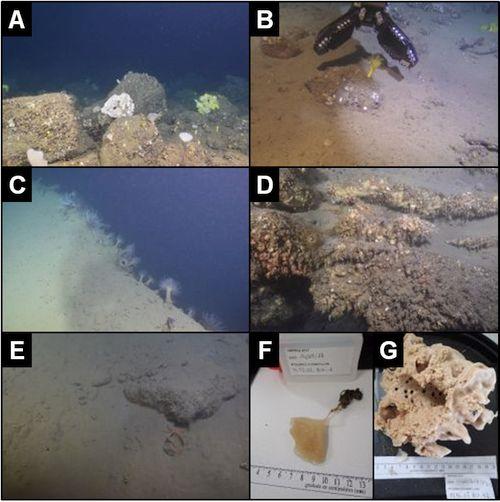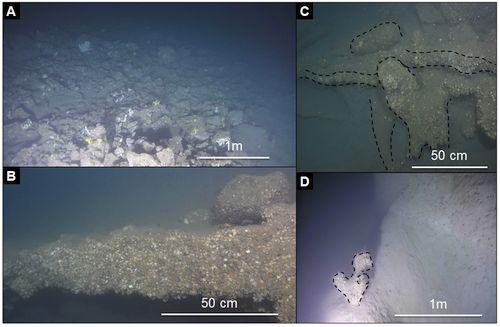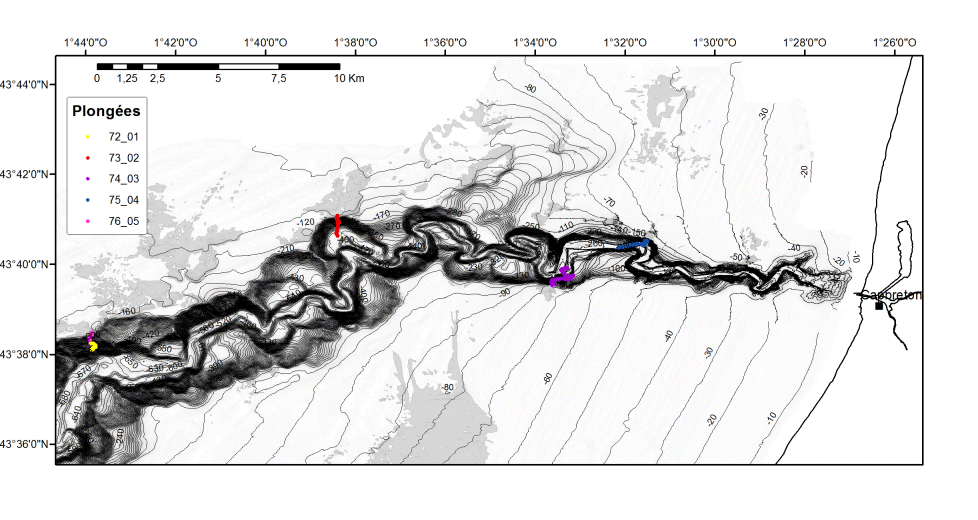Major results Ecology section
Samples were collected with a fauna aspirator and ROV jaw to identify the species observed by the Ariane HROV camera during dives PL73-02 and PL76-05. The samples were conditioned in alcohol or frozen. They were mainly sponges or bryozoans. The samples, coupled with video observations, showed the presence of two habitats of community interest (Ospar) in the Capbreton canyon area and the presence of ZNIEFF species:
- Colonies of pennatulas and burrowing megafauna" EUNIS A5.361 and A5.362;
- Deep water sponge aggregates " EUNIS A6.62
The acquisition of photos and videos during the 5 dives with the remotely operated HROV Ariane during the HapoGé campaign (Figure 1) made it possible to record various taxonomic groups in the Capbreton canyon, such as the scleractinians or hard corals including Dendrophyllia cornigera (Figure 5A and B) observed in the Blocs and Penfeld area (PL76- 05) and small fields of Cerianthes (figure 5C) on the edge of cliffs (or gullies) in this same zone. One of the major geological features that we observed at the "Roches du doigt mordu" (PL74-03) and Potromoncou/Regina (PL73-02) sites are the indurated strata richly colonised (figure 5D) by the benthic fauna (cnidarians, sponges, etc.) The burrowing megafauna such as the Paguridae, Munidae, Galathea and Nephropidae families are particularly visible on the muddy bottoms of these sites (figure 5E). Among the vagile fauna, taxa such as hake (Merluccius merluccius), gurnard (Chelidonichthys spp.) and small dogfish (Scyliorhinus canicula) were observed occasionally on the Boulders and Penfeld zone on bottoms of 190-265 m.
Biological samples taken with a fauna hoover or forceps during dives PL73-02 and PL76-05 made it possible to identify the sponge species (figure 5F and G). In particular, in the upper part of the habitat of community interest "Deep water sponge aggregates" (A6.62), 5 of the main taxa present belong to different families: Chalinidae (genus Haliclona and Cladocroce, figure 5F and G), Axinellidae, Hymedesmiidae and Esperiopsidae. The Bryozoan samples have not yet been evaluated.

Figure 5: Habitats. A. PL76 - Deep water sponge aggregates' EUNIS A6.62 (boulders with yellow coral Dendrophyllia cornigera and sponges at 185 m depth). B. PL76 - Ariane HROV grabbing of a small boulder with yellow coral. C. PL72 - Small colony of cerianthes in 330 m of water on a gully. D. PL74 - Benthic fauna colonising indurated strata (site "Roche du doigt mordu") at a depth of 90 m. E. PL73 - Burrowing megafauna habitat EUNIS A5.362 (galathea at a depth of 175 m). Collected biological samples with a fauna aspirator (F) or jaw (G) for identification.
Major results Pollutants section
This work enabled new knowledge to be acquired on marine pollution resulting from anthropic activities in the Capbreton submarine canyon, a transfer zone for particulate material from the continent to the deep ocean. An inventory was carried out on the presence of priority and emerging micropollutants in the sediments of the first 25 kilometres of this canyon. The sediments collected (Figure 3) in the canyon showed higher concentrations of micropollutants than in the sediments collected on the continental shelf, suggesting that the canyon is both a particle and micropollutant trap. Source determination using isotope tools showed a strong contribution from coastal effluents for the near-shore areas and a contribution from pelagic inputs for the more distant areas. The reactivity of some emerging micropollutants and mercury was examined by experiments under controlled conditions in order to identify the transformation processes and the bacteria involved. The degradation of emerging micropollutants is slow under anoxic conditions and much faster under oxic conditions. The degradation capacity observed for bacteria isolated from these sediments suggests their potential involvement in the bioremediation processes of organic micropollutants in the marine environment. The methylation and demethylation potentials of mercury showed a high biomethylation in anoxic coastal sediments, associated with sulphur cycle bacteria in particular (Figure 6). This work confirms that the Capbreton canyon, as certainly other submarine canyons, are important areas in terms of the transfer and transformation processes of micropollutants.

Figure 6: Example of transfer and transformation processes of mercury in the Capbreton canyon
Major results Geosciences section
Four separate sites were visited during the five dives of 3-6 hours duration (Figure 1). All dives started in the canyon thalweg or middle slope at depths ranging from 450 to 200 m. The HROV then explored the bottom and/or slopes, ascending to the canyon rim, and ending the dives at depths of around 100 m. With the analysis of the video and photo data from these dives using the Adélie software, and then with the laboratory analysis of the rock samples taken, the main geoscientific results obtained are the following
(1) Evidence of a turbid layer below the thalweg floor (canyon axis) over a thickness of 50 to 100m (Figure 7). Because of the apparent persistence of this turbid layer, also highlighted by the dives of the ATLANTHROV technical mission, which had preceded HaPoGé by one month, the suspension of these fine sediments in the water column from the bottom is more likely to be due to the action of internal waves (semi-diurnal tidal wave) than to the passage of very episodic turbidity currents. The systematic presence of this turbid layer, reducing visibility to a few decimetres, has unfortunately completely prevented the recognition and description of bedforms on the bottom of the thalweg.

Figure 7. A. Turbid layer in the water column overhanging the thalweg as seen from the Ariane HROV navigation camera. B. Representation of the location of this turbid layer on the canyon floor (upstream part).
2) Characterisation of the morphology and nature of the physical substrate in the side slopes of the canyon. Gentle, hilly slopes smoothed by hemi-pelagic sedimentation dominate the submarine landscape (Figure 8.A). However, much steeper landforms have been described: incised gullies with sharp interfluve ridges (Figure 8.B), sub-vertical and fresh outcrops that may correspond to recent landslide scars. In these slopes, two types of substrate are encountered: the intensely bioturbated mud of the gentle slopes and the vertical rocky slopes colonised by fixed organisms (encrusting sponges, bryozoans, bivalves, ...).

Figure 8. A. Typical aspect of the morphology of the side slopes of the canyon: soft and muddy slopes intensely bioturbated. B. Steep relief of an interfluve ridge between two gullies.
(3) Characterisation of rock outcrops on the upper slope and canyon rim. All the samples taken are fine to medium mixed silico-clastic/bioclastic sandstones with carbonate cements (Figure 4). They are intensely colonised by fixed organisms. Three morphologies are described: boulder and rock fields (on the shelf edge) (Figure 9.A); subhorizontal anispopaque sandstone beds (~1m) with metric clay interbanks (Figure 9.B); columnar vertical forms in interbanks or isolated (Figure 9.C), sometimes branched (Figure 9.D), of decimetric to multidecimetric diameter. Onshore analyses of these samples included thin-slice lithological microfacies, cathodoluminescence, XRF, calcimetry and carbonate isotopy (delta18O and delta13C ratios). The morphology of some of the samples is unambiguously suggestive of authentic cold seep crusts and conduits. As an important result of this study, isotopic analyses confirm that the cement of these sandstones is, at least in part, of authigenic origin with a signature of MDACs (Methane Derived Authignenic Carbonates).

Figure 9. Three types of rock outcrop morphology of the upper slope and canyon rim: boulder fields and boulders (A), subhorizontal anispopaque sandstone beds (B) and interbank columnar vertical forms (C), or isolated and branched (D)












